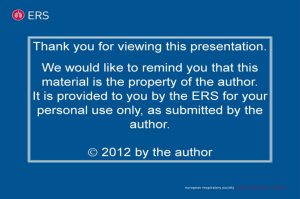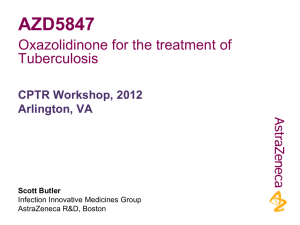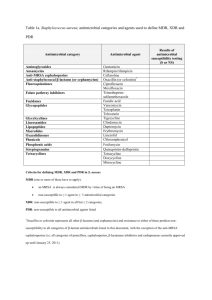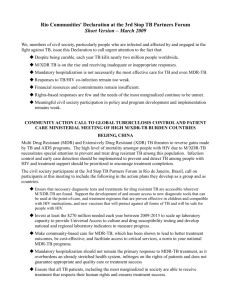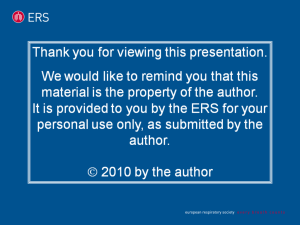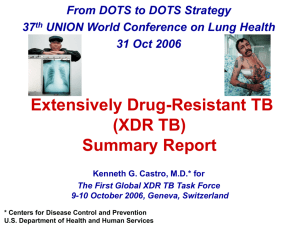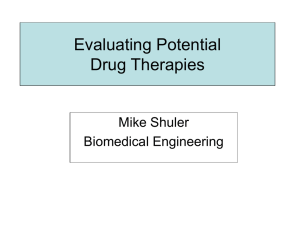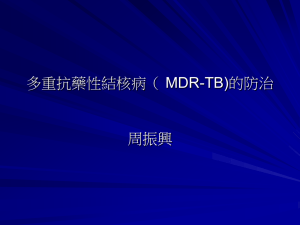XDR TB
advertisement
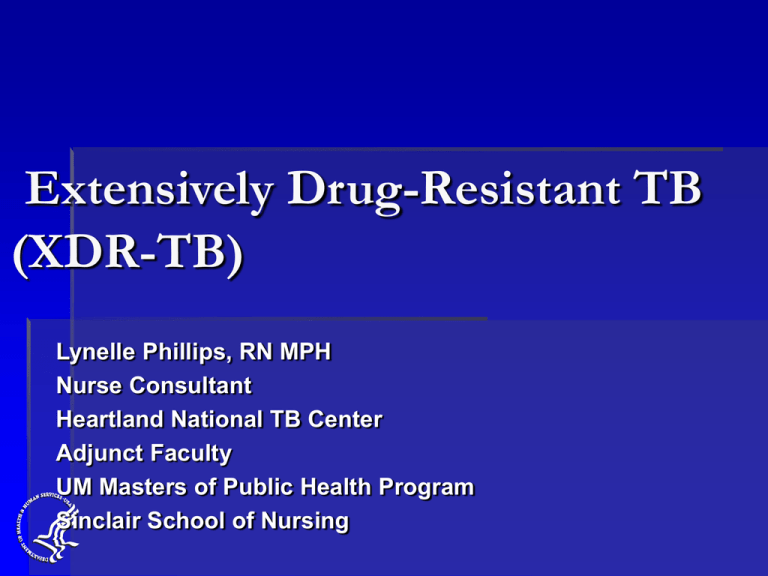
Extensively Drug-Resistant TB (XDR-TB) Lynelle Phillips, RN MPH Nurse Consultant Heartland National TB Center Adjunct Faculty UM Masters of Public Health Program Sinclair School of Nursing March 24, 1882 – “Do we know now, how to fight this enemy?” 1882 Robert Koch discovered the tubercle bacillus, Mycobacterium tuberculosis, the bacterium that causes tuberculosis. In 1890 Koch announced that he had discovered a substance that could protect against tuberculosis and even cure it. He announced the following year, that it was a glycerine extract of tubercle bacille, now known as “Old Tuberculin”. (Nobel Prize – 1905) Smithsonian Jan 2002 TB disease treatment regimen 1944 – Streptomycin – IM if rifampin resistant 1952 - Isoniazid – 6 months minimum Also for treatment of infected contacts 1952 – Pyrazinamide – 2 months 1962 – Ethambutol – discontinue if pansensitive 1966 – Rifampin – 6 months minimum Also for treatment of infected contacts A Silent Global Epidemic 1/3 of the world’s population infected 8 million new cases of active disease per year 2-3 million deaths per year One person is newly infected every second and one person dies every 10 seconds Rising incidence of drug-resistant disease Billions of dollars in lost productivity Estimated TB incidence rate, 2003 Rates per 100 000, all forms of TB 0 - 24 25 - 49 50 - 99 100 - 299 300 or more No estimate The designations employed and the presentation of material on this map do not imply the expression of any opinion whatsoever on the part of the World Health Organization concerning the legal status of any country, territory, city or area or of its authorities, or concerning the delimitation of its frontiers or boundaries. White lines on maps represent approximate border lines for which there may not yet be full agreement. © WHO 2004 Second-Line Drug Classes for MDR TB Treatment Aminoglycosides First line drugs Amikacin, Kanamycin Polypeptides Capreomycin Fluoroquinolones Ciprofloxacin, Ofloxacin Thioamides Ethionamide, Prothionamide + Serine analogues Cycloserine PAS WHO. Guidelines for the programmatic management of drug-resistant % Resistant Primary MDR TB in U.S.-born vs. Foreign-born Persons, United States, 1993–2005* 3 2 1 0 1993 1995 1997 1999 U.S.-born 2001 Foreign-born *Updated as of March 29, 2006. Note: Based on initial isolates from persons with no prior history of TB. MDR TB defined as resistance to at least isoniazid and rifampin. 2003 2005 Global WHO/IUATLD/CDC Survey Convenience sample (17,690 isolates) submitted to participating international SRL network, 2000-2004 3520 (20%) of isolates MDR TB 347 ( 2%) of isolates XDR TB XDRTB in all regions, more common FSU and Asia (Republic of Korea) Denominator information unavailable Number of MDR and XDR Cases, by Countries Submitting ≥ 1 M. tuberculosis Isolate to Participating SRLs, 2000–2004 Total MDR= 3520; XDR= 347 (~ 10% of MDR)* E. Europe MDR 406 XDR 55 (14%) Ind. Nations MDR 821 XDR 53 (6%) Rep. Korea MDR 1298 XDR 200 (15%) Asia MDR 274 XDR 4 (1%) Latin America MDR 543 XDR 32 (6%) Africa, Middle East Isolates contributed to survey MDR 156 XDR 1 (< 1%) * Country unknown, MDR= 102; XDR= 2 (2%) TB Treatment Outcomes, by Selected Drug Resistance Patterns, Latvia, 2000-2003* Cure Completion Death Default Failed Continue Tx HIV+ HR+AG+FQ HR+INJ+FQ HR+3SLD MDR-TB All 0 10 20 30 40 50 60 70 Percent * Leimane V, et al. WHO XDR TB Task Force Meeting. Oct 9, 2006 (from N = 820 evalu KZN Hospital Background* 119 patients in TB/ARV integration study 14 deaths 10 (71%) of 14 with MDRTB 6/10 MDRTB resistant to all tested first and second line drugs (SLD) for TB INH, RIF, EMB, STR, KANA, CIPRO Suggestive of probable extensive drug resistant TB in this hospital * Moll A, Gandhi NR, Pawinski R, Lalloo U, Sturm AW, Zeller K, Andrews J, Friedland G. HIV associated Extensively Drug-Resistant TB (XDR-TB) in Rural KwaZulu-Natal (South Africa MRC Expert Consultation Sept 8, 2006) KZN Drug Resistant TB Survey* Jan 2005 − Mar 2006 cross-sectional study of patients suspected with active TB in rural district hospital Isolates collected for mycobacterial culture (MGIT) and DST on all M. tuberculosis cultures INH, RIF, EMB, STR, KANA, CIPRO Chart reviews of patients with strains resistant to all tested drugs (“XDR TB” cases) Molecular fingerprinting by spoligotyping on all “XDR TB” isolates KZN Drug Resistant TB Survey Resu 1539 isolates tested 544 (35%) Cx+ M. tuberculosis 221(41%) MDRTB 995 (65%) Cx Negative 323 (59%) Susceptible 53 (10%) XDRTB (24% of MDRTB) * Moll A, Gandhi NR, Pawinski R, Lalloo U, Sturm AW, Zeller K, Andrews J, Friedland G. HIV associated Extensively Drug-Resistant TB (XDR-TB) in Rural KwaZulu-Natal (South Africa MRC Expert Consultation Sept 8, 2006) Characteristics of KZN XDRTB Patients Characteristics No prior TB Treatment Prior TB treatment Cure or Completed treatment Treatment Default or Failure HIV-infected (44 tested) Dead (Includes 34% on ARV) Identical M. tb spoligotype No. (%) 26 (51) 14 (28) 7 (14) 44 (100) 52 (98) 26/30 Global 7-point Action Plan to Combat XDR TB Emphasizes Essentials of Proper TB Control 1. 2. 3. 4. 5. 6. 7. Conduct rapid surveys of XDR-TB (determine burden) Enhance laboratory capacity (emphasis on rapid DST) Improve technical capacity of clinical and public health practitioners to effectively respond to XDR-TB outbreaks and manage patients Implement infection control precautions (PLHA focus) Increase research support for anti-TB drug development Increase research support for rapid diagnostic test development Promote universal access to ARVs under joint TB/HIV activities MRC Consultation, Johannesburg, South Africa. Sept 7, 2006 Reported Tuberculosis Cases in Foreign-Born Persons Missouri 1985-2006 60 percent number 50 40 30 20 10 0 8 19 5 8 19 6 8 19 7 8 19 8 8 19 9 9 19 0 9 19 1 9 19 2 9 19 3 9 19 4 9 19 5 9 19 6 9 19 7 9 19 8 9 19 9 0 20 0 0 20 1 0 20 2 0 20 3 0 20 4 0 20 5 0 20 6 0 20 7 Is there XDR TB in the U.S.? (MMWR: 4% of MDR Cases) XDR Analysis, 2000 – 2004 National TB Surveillance System Based on Revised WHO XDR TB Definition Resistant: 13 Tested: 509 Number of Reported TB Cases with XDR TB, U.S., 2000-2004 MMWR Definition Revised WHO Definition N= 18 (9 male) 13 (6 male) Age range 19-64 19-77 HIV (+) 2 1 HIV (−) 8 5 HIV NA/unk 3 7 CA 5 4 FL 2 0 NYC 7 5 NJ 1 1 IL, NV, TN 1 (ea) IL,NV, TX 1 (ea) ATS/CDC Recommends 4 Drug Regimen if INH Resistance Over 4% INH resistant ATS 4-drug guideline 10 8 6 4 2 20 05 20 03 20 01 19 99 19 97 19 95 0 19 93 % cases INH resistant 12 Comparison of INH resistance between all TB cases and foreignborn TB cases - 2006 70 60 50 40 % of total INH resistant 30 % of foreign born INH resistant 20 10 0 2000 2001 2002 2003 2004 2005 2006 1989 MDR TB outbreak Missouri 001mo.H3514 1991 1993 1997 RFLP testing 1998 1999 2000 2001 2002 Corrections Cx confirmed Clinical case Confirmed epi link Suspect link Inside DOC Outside DOC Migrants Entering U.S. Temporary visa holders: ~ 30,175,000 Visitors without visas: ~ 30,000,000 Immigrants and refugees: ~ 435,000 Undocumented immigrants: ~ 275,000 N= ~ 61,200,000 Status adjusters in U.S.: ~ 305,000 Source: U.S. Department of Justice, 1998 Opportunities for TB Prevention in Foreign-born Persons in U.S. Immigrants and Refugees Panel Physicians ICE Quarantine Stations Status Adjusters Civil Surgeons Immigrants and Refugees Health Departments Foreign-born Persons not Screened for TB before U.S. "Entry”, 1998 Visitors not requiring Visas: ~30, 000,000 Non-Immigrant Visas: 30,174,627 Temporary Visitors: Temporary Workers/family: Students/family: Transit Aliens: Treaty traders/family: Foreign government officials: Other Undocumented visitors: 27,766,580 458,519 598,520 365,607 144,572 126,543 714,286 ??? Source: U.S. Department of Justice, 1998 DGMQ authority …had not been tested since 1963 when a traveler suspected of small pox was quarantined. Do Not Board Tool Official request from CDC to DHS/OHA is required; Upon DHS/OHA’s approval, DHS request TSA to add the person to the Do Not Board list or requests Customs and Border Protection to add the individual to the Lookout list. The travel restrictions will prevent an individual from boarding a plane inbound, outbound, or within the U.S. Applies to aliens and U.S. citizens Do Not Board is NOT the same as Do Not Fly Do Not Fly is aimed at protecting civil aviation and the United States from acts of terrorism Persons on Do Not Board are not part of the Do Not Fly Missouri Statute 199.210 Missouri Rehabilitation Center July 1, 1996 MRC becomes directly affiliated with the University of Missouri at Columbia. Inpatient TB unit, approximately 9 negative pressure isolation beds. South Africa Involuntary detention WHO – patient assumes responsibility to isolate themselves from general public – may be too permissive? Judiciaries often have the authority to issue orders compelling involuntary confinement Missouri court order system “TB Patient Chafe Under Lockdown in South Africa” By Celia W. Dugger, Port Elizabeth, SA, March 25, 2008 The Jose Pearson TB Hospital here is like a prison for the sick. It is encircled by three fences topped with coils of razor wire to keep patients infected with lethal stains of TB from escaping. But at Christmastime and again around Easter, dozens of them cut holes in the fences, slipped through electrified wires or pushed through the gates in a desperate bid to spend the holidays with their families. Cont…. Patients have been tracked down and forced to return; the hospital has quadrupled the number of guards. Many patients fear they will get out of here only in a coffin. “We’re being held here like prisoners, but we didn’t commit a crime,” Siyasanga Lukas, 20, who has been here since 2006, said before escaping last week. “I’ve seen people die and die and die. The only discharge you get from this place is to the mortuary.” In the United States… Take Robert Daniels, the second most-famous TB patient these days. He has extensively drug-resistant Arizona TB Patient Jailed as a Public TB and is being held in an Arizona Health Menace hospital under court order. His case by Richard Knox raises even sharper questions about how to provide complicated treatment, protect the public, and prevent the spread of a dangerous new strain of TB. Listen Now add to playlist Robert Daniels with his wife, Alla, and their son in Moscow, before he returned to the United States. Courtesy KJZZ 91.5 FM Since last summer, Daniels has been locked in a bare room on the fourth floor of the Maricopa County Hospital in Phoenix. It's a jail unit for criminals who need medical care. But Daniels has never been charged with a crime. He's there because he's been judged a menace to public health. “There are no more borders. If one country suffers, every country suffers. If one country has infectious disease, every country has infectious disease” Dr. Juxel Garcia Deputy Director, PAHO
